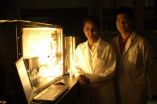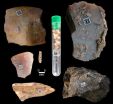(Press-News.org) Cambridge, Mass., January 19, 2011 – Invention and innovation are essential to remaining globally competitive, and a new survey shows an untapped group of potential inventors in the U.S. The 2011 Lemelson-MIT Invention Index , announced today, indicates that American women ages 16 – 25 possess many characteristics necessary to become inventors, such as creativity, interest in science and math, desire to develop altruistic inventions, and preference for working in groups or with mentors – yet they still do not see themselves as inventive. Young men in the same age group echo these characteristics, highlighting the need to cultivate young adults' interest in science and math, while educating and inspiring them about the impact they can have on others through invention.
Embracing Young Adults' Inventive Skills
The annual Lemelson-MIT Invention Index, which gauges Americans' perceptions about invention and innovation, this year surveyed young men and women ages 16 – 25. Almost three in four young women (71 percent) indicate they are creative, the characteristic they most associate with inventors (63 percent); however, less than one in three (27 percent) describe themselves as inventive. Men also follow this trend; 66 percent say they are creative but only 39 percent describe themselves as inventive.
Further demonstrating inventive traits, young women show a strong affinity for math and science – two of every five female respondents (42 percent) rate these as their favorite subjects in school. More than half of male respondents (53 percent) agree. 35 percent of young women also say they have a family member working in a field related to science, technology, math or engineering. The results reveal young women's innate interest in inventive fields; however, recent statistics show while more women are entering college and obtaining degrees, less than ten percent earn them in technical majors such as computer and information sciences, engineering or math.² This proportionately small group indicates a need to educate women about translating their skills and academic interests into inventive careers.
Chad Mirkin, a member of the President's Council of Advisors on Science and Technology (PCAST) and 2009 recipient of the $500,000 Lemelson-MIT Prize, recently remarked, "This country needs innovative new programs to stimulate the interest of young men and women in STEM and to challenge them to use their intellect and creativity to invent solutions to some of the world's most pressing problems. Women have an enormous amount to offer in this regard, but aren't currently pursuing science or technology fields at a high enough rate."
Fueling Future Innovation
The Lemelson-MIT Invention Index also reveals that young women and men do not see the U.S. as leading the way in invention; 61 percent of young women view Japan as the leader, with the U.S. ranking second at 27 percent. Young men agree, choosing Japan first (54 percent) and the U.S. second (36 percent).
To improve the U.S. standing, young women cite access to governmental funding (30 percent) and including invention projects during school (36 percent) as the best ways to encourage aspiring inventors. They cite lack of knowledge and concern about funding (65 percent) as the most challenging obstacles. Men agree, noting that providing places to develop inventions (24 percent) is another way to encourage hopeful inventors. The availability of invention tools and education has the potential to boost the quantity of inventive professionals, according to survey respondents.
Joshua Schuler, executive director of the Lemelson-MIT Program, supports this idea. "Our Lemelson-MIT InvenTeam grants initiative and partnerships with national youth organizations, which have access to millions of young people, inspire and empower youth to invent. To highlight a potential path to success, we also recognize award-winning college and professional innovators as accessible role models. We encourage parents, teachers and leaders at the state and national level to do their part and embrace innovation and seek out invention education experiences for youth."
Inventing for a Cause
The Lemelson-MIT Invention Index results indicate that young people have the skills necessary to invent, and also reveal that nearly half (49 percent) of young women are most interested in pursuing invention to improve the lives of others. Almost two in five men are also motivated to invent to improve lives (38 percent). 58 percent of the female respondents would make a health science or consumer product invention their top priority; men's inventive interest is geared towards consumer products or web-based inventions (54 percent).
Other Interesting Survey Findings
39 percent of men and 36 percent of women think that inventors are people who most often work at home or in their garage, illustrating a misperception of inventors and their careers.
Young adults show a preference for working in groups or with mentors (73 percent), the style typically associated with professionals in technical fields.
Young women are most interested in thinking of and designing a solution (57 percent) when it comes to the inventive process; men are also interested in those steps, as well as building the solution (84 percent).
INFORMATION:
ABOUT THE LEMELSON-MIT PROGRAM
Celebrating innovation, inspiring youth
The Lemelson-MIT Program recognizes the outstanding inventors and innovators transforming our world, and inspires young people to pursue creative lives and careers through innovation.
Jerome H. Lemelson, one of U.S. history's most prolific inventors, and his wife Dorothy founded the Lemelson-MIT Program at the Massachusetts Institute of Technology in 1994. It is funded by The Lemelson Foundation and administered by the School of Engineering. The Foundation sparks, sustains and celebrates innovation and the inventive spirit. It supports projects in the U.S. and developing countries that nurture innovators and unleash invention to advance economic, social and environmentally sustainable development. To date The Lemelson Foundation has donated or committed more than U.S. $150 million in support of its mission. For more information about the Lemelson-MIT Program, visit http://web.mit.edu/invent.
Survey reveals potential innovation gap in the US
2011 Lemelson-MIT Invention Index uncovers inventive perception among young Americans
2011-01-20
ELSE PRESS RELEASES FROM THIS DATE:
Parental divorce linked to suicidal thoughts
2011-01-20
TORONTO, ON –Adult children of divorce are more likely to have seriously considered suicide than their peers from intact families, suggests new research from the University of Toronto
In a paper published online this week in the journal Psychiatry Research, investigators examined gender specific differences among a sample of 6,647 adults, of whom 695 had experienced parental divorce before the age of 18. The study found that men from divorced families had more than three times the odds of suicidal ideation in comparison to men whose parents had not divorced. Adult daughters ...
Case Western Reserve and Athersys show regenerative benefit of MultiStem after spinal cord injury
2011-01-20
Case Western Reserve University School of Medicine and Athersys, Inc. (NASDAQ: ATHX) announced a joint scientific study on spinal cord injury will be published today in the January issue of the Journal of Neuroscience. The study, by leading researchers from the Department of Neurosciences at the School of Medicine and scientists at Athersys, presents data supporting the potential therapeutic benefit of Athersys' MultiStem® program for spinal cord injury. Researchers observed that administration of Multipotent Adult Progenitor Cells (MAPC) following spinal cord injury in ...
New reactor paves the way for efficiently producing fuel from sunlight
2011-01-20
PASADENA, Calif.—Using a common metal most famously found in self-cleaning ovens, Sossina Haile hopes to change our energy future. The metal is cerium oxide—or ceria—and it is the centerpiece of a promising new technology developed by Haile and her colleagues that concentrates solar energy and uses it to efficiently convert carbon dioxide and water into fuels.
Solar energy has long been touted as the solution to our energy woes, but while it is plentiful and free, it can't be bottled up and transported from sunny locations to the drearier—but more energy-hungry—parts ...
Malaria parasite caught red-handed invading blood cells
2011-01-20
Australian scientists using new image and cell technologies have for the first time caught malaria parasites in the act of invading red blood cells. The researchers, from the Walter and Eliza Hall Institute in Melbourne, Australia, and the University of Technology, Sydney (UTS), achieved this long-held aim using a combination of electron, light and super resolution microscopy, a technology platform new to Australia.
The detailed look at what occurs as the parasite burrows through the walls of red blood cells provides new insights into the molecular and cellular events ...
Fears of Ontario pharmacy shortage after slashed generic drug prices unfounded: UBC research
2011-01-20
A University of British Columbia study shows that there are enough pharmacies situated throughout Ontario communities to absorb many closures without negatively affecting geographical accessibility for residents. The research suggests concerns that reducing generic pricing could result in pharmacy shortages are unfounded.
Last summer, the Ontario government cut the price of generic drugs by half – to approximately 25 per cent of the equivalent brand – leading to heated discussions on the sustainability of existing pharmacies. Some pharmacy chains claimed they might be ...
Man, volcanoes and the sun have influenced Europe's climate over recent centuries
2011-01-20
An International research team has discovered that seasonal temperatures in Europe, above all in winter, have been affected over the past 500 years by natural factors such as volcanic eruptions and solar activity, and by human activities such as the emission of greenhouse gases. The study, with Spanish involvement, could help us to better understand the dynamics of climate change.
Up until now, it was thought that Europe's climate prior to 1900 was barely affected by external factors, but now a group of scientists has shown that natural phenomena such as volcanic eruptions ...
Unfolding pathogenesis in Parkinson's
2011-01-20
The study, published in the Journal of Clinical Investigation, reveals that damaged alpha-synuclein proteins (which are implicated in Parkinson's disease) can spread in a 'prion-like' manner, an infection model previously described for diseases such as BSE (mad cow disease).
"This is a significant step forward in our understanding of the potential role of cell-to-cell transfer of alpha-synuclein in Parkinson's disease pathogenesis and we are very excited about the findings", says Professor Patrik Brundin at Lund University, Sweden, who led a team of investigators from ...
Neiker-Tecnalia makes progress in detection and prevention of infection by visna maedi virus
2011-01-20
Researchers at Neiker-Tecnalia (the Basque Institute for Agricultural Research and Development) have undertaken a study on the epidemiology and diagnosis of infection by visna/maedi virus. This is a virus that affects sheep herds causing chronic interstitial pneumonia, mastitis and neurological disorders. The study confirmed that horizontal transmission (direct contact between infected animals) of the virus is the most likely path of infection, rather than vertical transmission (from infected suckling milk or colostrum). Since there is no current effective treatment against ...
Data matrix codes used to catalogue archaeological heritage
2011-01-20
The research team at the Centre for the Studies of Archaeological and Prehistoric Heritage (CEPAP) of Universitat Autònoma de Barcelona (UAB) have implemented an innovative system to register archaeological artefacts which eliminates problems in manual markings, such as errors in writing or erosion of data. The system, based on direct labelling using bi-dimensional data matrix (DM) codes, has been used by the CEPAP team during two years, in which numerous artefacts and bone remains from sites in Spain and Africa were registered.
The marking of archaeological material, ...
Challenging the limits of learning
2011-01-20
Tel Aviv -- Although we're convinced that baby is brilliant when she mutters her first words, cognitive scientists have been conducting a decades-long debate about whether or not human beings actually "learn" language.
Most theoretical linguists, including the noted researcher Noam Chomsky, argue that people have little more than a "language organ" -- an inherent capacity for language that's activated during early childhood. On the other hand, researchers like Dr. Roni Katzir of Tel Aviv University's Department of Linguistics insist that what humans can actually learn ...
LAST 30 PRESS RELEASES:
Application of orthogonal CNOP-I in a convection-allowing ensemble prediction system based on CMA-MESO for improving extreme precipitation skill
Study suggests bamboo has ‘superfood’ potential
Hidden heart-care gaps among Asian American patients
Blood test predicts which patients with lung cancer will benefit from newly approved immunotherapy drug
SwRI’s Dr. Michael Davis named SPIE Fellow
Exposure to “forever chemicals” linked to higher risk of gestational diabetes, major review finds
Insilico Medicine integrates Nach01 Foundation Model with Microsoft Discovery to enable AI-native, enterprise-ready drug discovery workflows
New study reveals precursors for forecasting summer clustered extreme precipitation events in Northeast China
A bacterial toxin can counteract colorectal cancer growth
Frozen hydrogen cyanide ‘cobwebs’ offer clues to origin of life
Physics of foam strangely resembles AI training
Bis-pseudoindoxyls: a new class of single benzene-based fluorophores for bioimaging applications
Blocking a cancer-related pathway helps reduce spine deformities due to genetic disorder, finds new study
New study explores therapeutic potential of CRISPRCas3 genome-editing system
Korea University researchers revive an abandoned depression drug target using structurally novel NK1 receptor inhibitors
Jeonbuk National University researchers highlight advancements in chemical looping fluidized bed reactors
Tyrannosaurus rex grew up slowly: New study reveals the “king of dinosaurs” kept growing until age 40
Commercial water dispenser machines may contain more contamination than tap water
Death and doctors: New WSU study looks at medical student education on end-of-life care
The best hydrogen for heavy-duty transport is locally produced and green
Pregnancy-related high blood pressure varied among Asian, Pacific Islander subgroups
Measuring movement creates new way to map indoor air pollution
Europe’s crop droughts to get worse even as rain increases
New study identifies signature in blood to better predict type 2 diabetes risk
Research spotlight: developing “smart” nanoparticles to deliver targeted gene therapy in osteoarthritis
A CRISPR fingerprint of pathogenic C. auris fungi
Time warp: How marketers express time can affect what consumers buy
CBD treatment reverses key effects of fetal alcohol spectrum disorder in a mouse model
Blood sugar spikes linked to higher risk of Alzheimer's disease
Staying single for longer affects young people’s well-being
[Press-News.org] Survey reveals potential innovation gap in the US2011 Lemelson-MIT Invention Index uncovers inventive perception among young Americans




